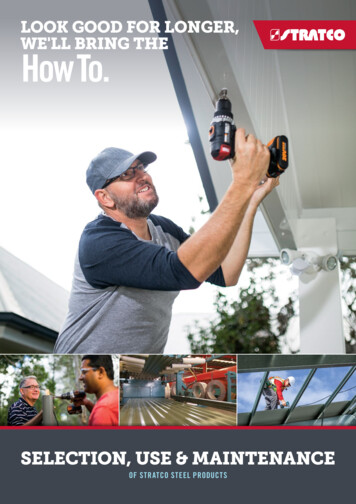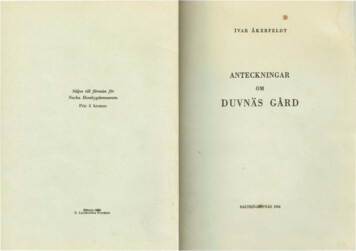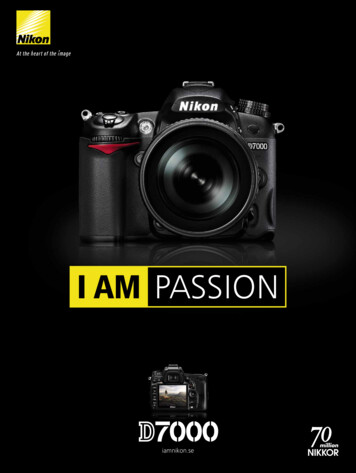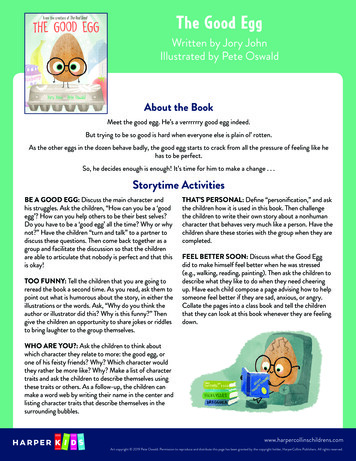
Transcription
LOOK GOOD FOR LONGER,WE'LL BRING THESELECTION, USE & MAINTENANCEOF STRATCO STEEL PRODUCTS
SELECTION, USE & MAINTENANCEPRODUCT SELECTIONWIDE PRODUCT RANGECORROSION PREVENTIONStratco produces a wide range of products and materials forthe building and home improvement industry as well as forindustrial applications. Various thicknesses, widths, coloursand finishes are often available, so it is important to clearlyspecify your requirements when placing an order.Corrosion is prevented on Stratco steel products by eithera galvanised (zinc), Zinc/Al (zinc/aluminium) or AM (zinc/aluminium/magnesium) protective coating. The product mayhave an additional colour surface. The raw edges of newly cutsteel are unlikely to rust because this coating will sacrifice itselfto prevent corrosion forming.WIDE COLOUR RANGEA wide range of colours is available to suit any environment.The colour is usually supplied single-sided with a light colouror washcoat on the reverse side. The colour surface is thickeron the main colour side for extra life. On the reverse side,some colour variation can occur. Due to our harsh Australianclimate, some colour fading may occur over time; dark coloursare more likely to fade, but the colour change is usually slowand even.When flat steel is rolled into a profile, lubricant is applied to thesteel to aid the process. This lubricant usually evaporates quickly.Sometimes the steel mill applies a yellow chromate coatingto protect the steel, this coating will simply weather-off.Some Stratco products have specific performance guaranteeswhile others merely refer to a typical life in normal conditions.Consult your nearest Stratco to discuss details of your project.FINISH COLOUR COATCORROSION INHIBITIVE PRIMERCONVERSION COATINGZINC/AL, AM OR GALV COATINGBASE METALZINC/AL, AM OR GALV COATINGCONVERSION COATINGCORROSION INHIBITIVE PRIMERPROTECTIVE WASHCOATNOTE: CUT EDGES ARE CATHODICALLY PROTECTED BY GALVOR ZINC/AL COAT WHICH INHIBITS THE BASE METAL RUSTING.FIGURE 1.0 - STRATCO STEEL CROSS SECTIONCONSIDER YOUR ENVIRONMENTYOUR DESIGN IS IMPORTANTYour steel product will have a long life-span if it is usedaccording to Stratco specifi cations. Stratco can providecomprehensive literature on all our products. Literature thatcovers important points such as; roof pitch, support spacing,metal thickness and laying procedures.Unusual loads such as wind, snow or other adjoining materialsneed to be considered by the owner when designing a structure.ENVIRONMENTAL CONSIDERATIONSThe area a steel product will be used in needs to be considered.While roofing and purlin materials in outer urban and rural areasmay have a life-span in excess of 30 years, this can reduce toonly a few years in severe coastal or industrial environments.A steel product in a non-aggressive environment will have along life-span. Non-aggressive areas are outer urban and ruralareas, away from pollution and the shoreline. In an aggressiveenvironment a steel products life-span may be reduced. Theseare coastal and industrial areas, close to salt water and pollution.In very severe conditions material with a stainless steel baseshould be used. In both severe and some moderate conditionsthe material will need a thicker primer coat with a paintdesigned for aggressive environments. Alternatively, it may besuitable to adopt an increased maintenance program. In benignand moderate conditions, normal pre-painted steel is suitable.Very severe conditions are within 200 metres of active surfand industrial pollution. Severe conditions are between 200to 1000 metres of these areas. Moderate conditions can stillcontain salt or moist, acid laden air for up to 1000 metresaway from surf or industrial pollution. Benign conditions areouter urban and rural areas far away from the shoreline.Severe conditions also include areas close to swimming poolsand spas. Zinc/Al, AM, galvanised and pre-painted steelshould not be used in these areas without an appropriatemaintenance program. Concrete should not be pouredagainst Zinc/Al based products. Any material that retainsmoisture such as dirt, compost or paving sand should notbe placed against steel and Zinc/Al based products.Galvanised steel may be suitable in specific circumstances forareas around animal shelters, formwork, or embedded inconcrete. Check with Stratco before using in these environments.The steel manufacturer can provide additional information andthey should be consulted whenever you are uncertain of whatfinish is suitable for your application.GENERAL SHEETMETAL PRODUCTSDistance from surf &industrial pollutantsSUGGESTED MATERIALPURLIN & CARPORT FASCIA PRODUCTSDistance from surf &industrial inlesssteel baseFIGURE 2.0Severeenvironmentpre-painted steelPre-painted steel,Zinc/Al, AM,galvEnclosedbuilding(dry, notventilatedexternally)SUGGESTED MATERIALVerandahscarportsZ350 COATED PURLINNON-AGGRESSIVEENVIRONMENTOpen sidedbuildingVerandahscarportsZ450 COATED PURLINAGGRESSIVEENVIRONMENT
OF STRATCO STEEL PRODUCTSTHINGS YOU SHOULD KNOW ABOUT STEELWHY STEEL RUSTSWhen iron comes into contact with air, a thin porous film of ironoxide forms on it. If moisture is present an electric cell is formedbetween the iron and the oxide. Current flows through themoisture dissolving the iron and forming rust. In seaside orindustrial atmospheres, or where incompatible metals are used,the current in the cell increases causing rust to form quicker.INCOMPATIBLE METALSGalvanised steel can be used with lead, but Zinc/Al, AM coated andpre-coloured steel cannot. Galvanised steel and pure zinc materialcan be used with Zinc/Al, AM. Copper cannot be used with thesematerials and monel should not be used with Zinc/Al, AM.Fixings such as rivets and self-drilling screws should be compatiblewith the material they are fixing. The best way of reducingcorrosion is to keep incompatible metals apart.RUN-OFF FROM OTHER SURFACESWater should not be allowed to flow from copper or lead overZinc/Al, AM sheet, or from copper over galvanised material. Inaddition water should not flow from Zinc/Al, AM or pre-painted steelover galvanised material. The overflow from air-conditioningsystems often runs onto metal roofing causing rapid deterioration.Suitable flowof waterGALVANIC TABLEIn a bimetallic pair, the galvanic table is usedto predict which metal will corrode. The metalcloser to the anodic end will corrode if thewater flows from the cathodic end. The furtherapart the two metals are on this chart, thefaster the corrosion will take place.Unsuitable water flowcauses rapid corrosion ANODICZincZinc/Al, AMAluminiumCadmiumHigh strength aluminiumIron and steelSoft solderLeadTinBrassCopperBronzeSilver- CATHODICFIGURE 3.0EXPANSION AND CONTRACTIONWhen using very long lengths of steel, thermal expansion shouldbe considered. For example: a 15 metre metal sheet can expandup to 12mm over a temperature rise from 0 C to 65 C. The use ofexpansion joints can overcome this. Gutter expansion joints insteel should be included in any run over 20 metres.GUTTER EXPANSION JOINTFIGURE 4.0CONDENSATIONCondensation occurs when there is a difference in temperaturebetween two adjacent air masses, such as where warm moist airin a roof space meets a roof sheet in contact with cold outside air.Here the dew point is quickly reached and condensation occurs.To avoid this, a vapour barrier or sarking should be used toprevent moisture from forming.COMPLY WITH REGULATIONSAll building work must be carried out in accordancewith the Building Code of Australia (BCA).This code refers to various Australian Standards,which provides acceptable standards of productmanufacture and building practice. These include: AS/NZ 3500.3 Plumbing and Drainage,Stormwater DrainageProspective users of Stratco materials should firstensure that they understand these requirementsand any other state or territory specific regulationsthat may apply. In some states of Australia (eg. NSWand Victoria) work involving the installation ofroofing, rainwater goods and drainage may needto be installed by a suitably qualified tradesperson,and comply with statutory warranties.(Refer ‘www.deus.nsw.gov.au/water/plumbing.asp’)Care should also be taken in the design andinstallation of roof drainage systems given thewide range of factors such as rainfall intensity,gutter capacity and selection, number andplacement of downpipes and sumps.Care should also be taken to select the mostsuitable gutter style. Gutters that have a fronthigher than the back are popular to hide theexposed ends of roofing, but unless manufacturedwith optional slots or fixed with the bead lowerthan the top of the fascia may contravene buildingregulations. Other fixing options can be used toeliminate overflow from the back of a gutter intoa building. These include additional overflow weirsplaced either in the gutter or stop end, rainheadswith overflow weirs, custom back fl ashings,leaving a gap between the fascia and gutter back,or other proprietary systems or trade solutions.Drainage, solar power generation, hot watersystems and the installation of rainwater tanksmay also be dependant on state and localgovernment regulations. Users and installersshould first check with these authorities whendetermining their requirements.Up to date information about Stratco products, spans,installation requirements and technical advice canbe found on our website at ‘www.stratco.com.au’ andit is advisable to obtain current information prior toordering any materials. For information on installingHigh Fronted Gutters please refer to the Stratco‘High Fronted Gutters Information Guide’ on theStratco website. If additional information isrequired contact the Stratco office in your state.
CUTTING STEELWhen marking steel for cutting use a coloured pencil. Black orlead pencil contains graphite that will promote rust. Use handtools such as a hacksaw or snips for cutting steel. If this isimpractical, use steel metal cutting blades in a power saw.SWARF DAMAGEPower tools when cutting, drilling and filing steel cause hotmetal particles called swarf. The hot particles weld themselvesto surrounding metal surfaces, then rust, causing unsightlybrown stains that are very visible on coloured steel.Avoid swarf damage by cutting away from other sheets or byusing a cover. When cutting coloured steel with a saw, usepadded supports and cut the sheets with the colour face down.After work has finished, always sweep down new roofs andclean the gutters to ensure rivet stubs and metal cuttings areremoved. Mild swarf staining does not mean the steel itself willrust as the steel core is surrounded by a protective coating.The effect is mainly visual unless the damage is severe.SWARF REMOVALSwarf can be removed from steel by scrubbing the area witha stiff nylon brush dipped in a mild detergent solution. Rinsethe surface with water afterwards to ensure any particles arewashed away. If necessary, mop up any excess water with aclean cloth. Ensure any particles that are swept into the guttersare removed. If swarf staining has already occurred it isnot easily removed and badly affected areas mayneed to be painted or replaced.FIGURE 5.0FIXING STEEL PRODUCTSFASTENER SELECTIONSEALANT SELECTIONRivets are ideal for holding together two thin layers of material,such as sheeting, or sheeting to a steel rail. There are severaltypes of rivet available, choose one that is compatible withyour material and is the correct size for your job. Rivets can besealed or non-sealed, and a smear of silicon over the rivet isrecommended where weather proofing is required.While there is a wide range of sealants available, not all arecompatible with Stratco steel products. Silicone sealants havethe flexibility of being able to join galvanised, Zinc/Al, AMand pre-painted steels. Mastic type sealants will not usuallylast as long as is required. Soldering is an acceptable form ofjoining galvanised product together, but Zinc/Al, AM coatedsteel cannot be soldered.Self-drilling and tapping screws are fast and strong and canbe found with a neoprene washer for sealing. They have anunthreaded drilling point so that the drilling action iscompleted before the thread starts to engage. The length ofthe unthreaded point needs to be as long or longer than thematerials thickness. Use screws with a seal for roofing.To prevent water intrusion, crest fixing is recommended tokeep the screw out of the path of the water.Type 17 screws work in a similar way to self-drilling andtapping screws but are used for timber. It is important thatthe fastener has the same life as the material being fixed.When choosing a silicone sealant, it must be suitable forroofing and guttering use, and of a non-acetic, amine free,neutral cure type. Sealants that smell of ammonia, vinegar orlemons are not usually suitable.Silicone sealants should be applied as a gasket, sandwichedbetween the two surfaces to be joined. Refer to Figure 7.0through to Figure 9.0 for an example of creating a gasket.This method not only creates a strong join but it protects thesealant from UV exposure. Always remove metal filings fromthe area to be joined and smear the sealant over any fasteners.Fasteners selected must be suitable for the environment.SELF-DRILLING SCREWSEALANT APPLICATION: STEP 1SEALANT APPLICATION: STEP 2SEALANT APPLICATION: STEP 3CLEAN THESURFACEAPPLYSILICONEJOIN THETWO SURFACESFIGURE 7.0FIGURE 8.0FIGURE 9.0TYPE 17 SCREWRIVETADAPTORFIGURE 6.0
PROTECTING YOUR INVESTMENTSAFETY FIRSTSTANDARD STRATCO SAFEGUARDSHANDLING STEELScuffing and scratching can damage steel with a pre-colouredfinish. To minimise this, Stratco supplies some products such asgutters, downpipes, flashings and ridging with a removable plasticcoating. Do not leave this coating exposed to the sunlight for longperiods of time because it may be hard to remove. Coloured steelsheeting is supplied either wrapped in plastic and cardboard orwith the top sheet turned over. The reverse side is normallyunprotected, but extra packing sheets can be supplied at thecustomer’s cost, and are a good idea if double sided colourfencing sheets are ordered.Always take appropriate safety precautions whenhandling steel products. The edges of many steelproducts, especially steel sheeting, can be verysharp and will easily cut. Always wear cut-resistantgloves that are clean and dry to prevent markingthe steel surface, and to prevent the steel fromcutting the skin.STORAGE AND HANDLING OF STEELFor safety, wear gloves when handling steel sheets. Ensure yourhands or gloves are clean, especially when handling Zinc/Al, AMwhich can mark. Steel products should be kept dry before installation.This is important for tightly nested products such as packs ofcorrugated iron. Separate and dry these products immediatelyif they get wet, as discolouration can occur.REMOVE PLASTIC COATINGFIGURE 10.0PAINTING STEEL PRODUCTSTOUCHING UP SCRATCHESPre-painted steel may get scratched while being handled, howeverthe use of touch-up paints is not recommended. They will weatherdifferently to the original oven cured coating and this may causevariations in colour and exaggerate minor blemishes over time.In most cases, minor damage to roofing and guttering cannotbe seen and any attempt to overspray the damage may becomemore unsightly in the future.The consumer must accept that some minor scratches will beinevitable on low-level projects such as verandahs and carports.Fabricators and erectors should ensure that maximum care istaken to protect pre-painted steel surfaces from damage.Replacements should be considered if the damage is severe.Additional over painting information is available from Stratco.OVER PAINTINGZinc/Al, AM coated steel can be painted withoutthe need for an etch primer. Some paints allowgalvanised material to be over paintedwithout priming so check your paintfor details. Steel supplied with apre-painted surface can be repaintedwith minimal preparation.Many steel products are used and installed outdoorsand hence it is recommended that suitable sunprotection is applied when installing or using steelproducts outside.However, it is important to note that sunscreensthat include semi-conducting metal oxides like zincoxide (ZnO) and titanium dioxide (TiO2) can speedthe deterioration of paint. To protect the surface ofpre-painted steel, prevent sunscreens that containtitanium dioxide (TiO2) and zinc oxide (ZnO) fromcoming into contact with the painted surface.BEWARE OF WET, WINDY CONDITIONSThe installation of Stratco steel products in wetand windy conditions can be dangerous. Wheninstalling steel sheets, the wind can easily lift thesheets causing damage to people and property.Always ensure that roofing is securely tied downbefore fixing. Walking on roofing or using powertools in wet conditions is dangerous.WALKING ON ROOFINGOn metal roofing, it is important to walk on thepurlins. This is both for safety and to avoid damageto the roof. Try to keep your weight evenlydistributed and walk flat footed rather than with aheel and toe action. When walking on corrugatediron, spread your weight over as many corrugationsas possible. On high profile decking only walk inthe pans of the sheet.When delivered, some sheets have an oily film thatcan be slippery especially when damp. Take extremecare when handling them.TRANSLUCENT SHEETINGStratco markets translucent fibreglass andpolycarbonate. Special wire safety mesh mustbe used to support the sheeting when used incommercial and industrial applications. This is nottypically required in domestic applications, but adanger of falling through the sheeting still existsand care should be taken.TOUCH-UP PAINT IS NOT RECOMMENDEDFIGURE 11.0FIGURE 12.0
MAINTENANCENORMAL MAINTENANCEAREAS NOT WASHED BY RAINRegular maintenance is essential to maintain the good looksof your Stratco steel product. It will ensure you receive themaximum possible life-span for a steel product in your location,this is especially important for coloured pre-painted steel.More regular maintenance is required on the areas of a productthat are not naturally washed by rain. These areas include theunderside of verandahs and carports, roofing visible throughexposed eaves, and steel fascias and gutters. Other productssuch as garage doors and cladding under eaves may also requireadditional attention. A products life-span may be reduced fromnot following a regular maintenance program because nighttime condensation in these areas can combine with salt andpollution on the surface, resulting in accelerated corrosion.To maintain the product’s surface, wash it with clean water atleast every six months. A more frequent wash is recommendedin coastal or industrial areas. Maintenance must be frequentenough to prevent dust, salts, pollutants and any other materialto accumulate on the product and reduce its life. Products thatare regularly washed by rain require no additional maintenance.Avoid locating a Stratco steel product near polluted areas or inareas with aggressive environmental factors that could reducethe life of the steel. This includes areas near barbecues, dieselfumes, air-conditioners, clothes dryers, sprinklers, bore water,water softeners and industrial applications. Stratco steelproducts and materials are not recommended for use asenclosures for swimming pools or spas.Wash areas that are not naturally cleaned by rain with fresh,clean water. It is recommended that you clean the surfaceas often as you would wash your car to maintain its duco.In marine or industrial environments you should wash moreoften. Maintenance must be frequent enough to preventdust, salts, pollutants and any other material to accumulateon the product and reduce its life.If washing with clean water does not completely clean thesurface, a mild solution of detergent should be added to thewater and applied with a soft bristled nylon brush. Rinse thecoloured surface thoroughly. Never use abrasive or solventbased cleaners such as turps, petrol or kerosene.Contact Stratco or the steel manufacturer for more informationon the correct maintenance for your application.FIGURE 13.0This brochure has been produced in the interest of customer education and good consumer relations. Stratco haveendeavoured to provide the most technically correct and up-to-date advice possible but assume no responsibilitywhatsoever in relation to such information or advice. Alteration in the recommendations may occur from time totime. Please contact Stratco for the most up-to date advice available prior to using this information. Additionalinformation is available from steel manufacturers, other Stratco technical bulletins, trade schools and othercompetent bodies, and these should be consulted prior to purchasing and installation of Stratco steel products.Consumers should satisfy themselves that they are using the correct materials, approach and techniques.« SCAN THIS QR CODE TO FIND A STRATCO NEAR YOU1300 155 155stratco.com.auBROCSUMAll brands and logos/images accompanied by or are trade marks of Stratco (Australia) Pty Limited. Copyright June 2013
systems often runs onto metal roofi ng causing rapid deterioration. EXPANSION AND CONTRACTION When using very long lengths of steel, thermal expansion should be considered. For example: a 15 metre metal sheet can expand up to 12mm over a temperature rise from 0 C to 65 C. The use of expansion joints can overcome this. Gutter expansion joints in











